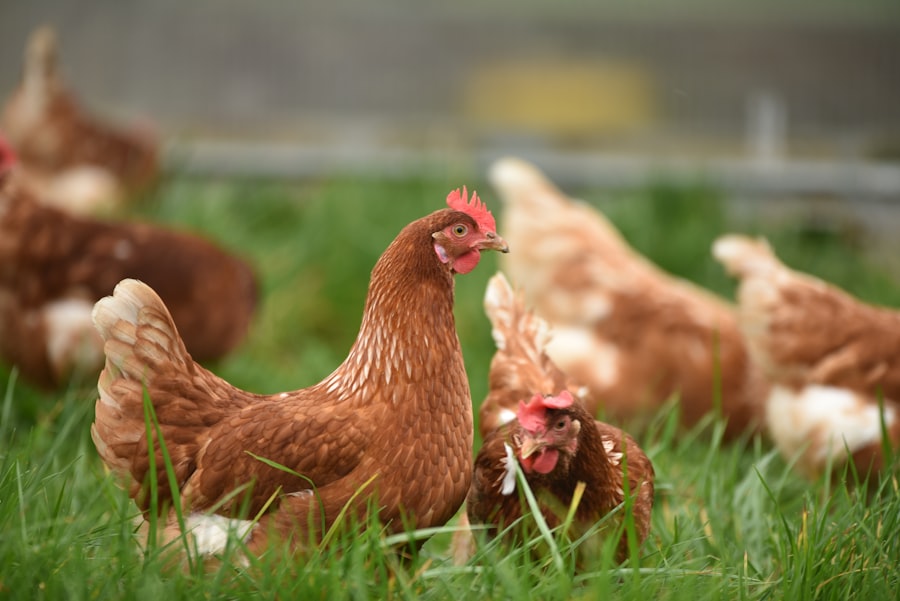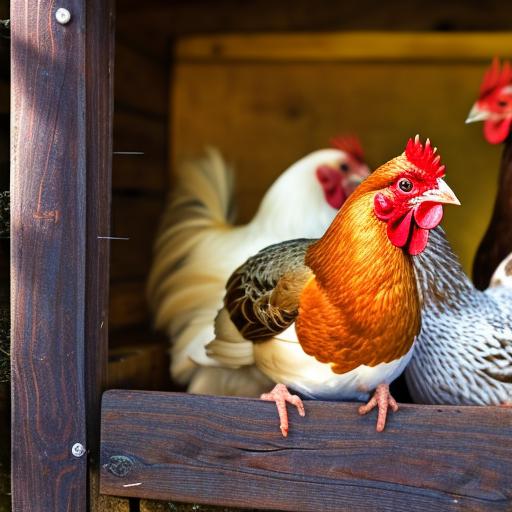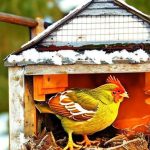Winter can be a challenging time for chickens, as they are susceptible to cold temperatures and frostbite. Unlike mammals, chickens do not have the ability to regulate their body temperature as effectively, making them more vulnerable to the cold. Keeping chickens warm is essential for their health and well-being, as well as for egg production.
Chickens that are exposed to extreme cold temperatures can suffer from frostbite, which can lead to tissue damage and even death. Additionally, cold temperatures can cause stress in chickens, which can weaken their immune system and make them more susceptible to diseases. In order to keep your chickens healthy and productive during the winter months, it is important to provide them with a warm and comfortable environment.
Key Takeaways
- Keeping chickens warm is important for their health and well-being during winter.
- Choosing the right insulation materials for your coop can help regulate temperature and prevent drafts.
- Proper ventilation is crucial for balancing warmth and fresh air flow in the coop.
- Safe and effective heating methods, such as radiant heaters, can be used to warm up the coop.
- Providing a comfortable and insulating layer of bedding for your chickens can help keep them warm and cozy.
Insulation: Choosing the Right Materials for Your Chicken Coop
Insulation is key to keeping your chicken coop warm. Without proper insulation, cold air can seep into the coop, making it difficult for chickens to maintain their body temperature. There are several materials that you can use to insulate your coop, including fiberglass, foam board, or straw bales.
Fiberglass insulation is a popular choice for chicken coops because it is easy to install and provides excellent insulation. It comes in rolls or batts that can be cut to fit the walls and ceiling of your coop. Foam board insulation is another option that provides good insulation and is resistant to moisture. Straw bales can also be used as insulation by stacking them around the perimeter of the coop. They provide excellent insulation and can also serve as a source of bedding for your chickens.
Ventilation: Balancing Warmth and Fresh Air Flow
While insulation is important, ventilation is equally crucial. Proper ventilation will prevent moisture buildup and ensure fresh air flow, while still maintaining warmth. Without proper ventilation, condensation can occur inside the coop, leading to dampness and an increased risk of respiratory diseases.
To provide adequate ventilation, make sure that your coop has vents or windows that can be opened and closed as needed. It is important to strike a balance between keeping the coop warm and allowing for fresh air flow. You can use adjustable vents or windows to regulate the airflow and prevent drafts.
Heating: Safe and Effective Ways to Warm Up Your Chicken Coop
Heating your chicken coop can be dangerous if not done properly. It is important to use safe and effective methods to keep your chickens warm. One option is to use a heat lamp, which can provide a source of warmth for your chickens. However, it is important to use a heat lamp that is specifically designed for use in a chicken coop and to follow the manufacturer’s instructions carefully.
Another option is to use a heated waterer, which can help prevent the water from freezing and provide some warmth to the coop. It is important to choose a heated waterer that is designed for use with chickens and to ensure that it is placed in a safe location where it cannot be knocked over or cause a fire hazard.
Bedding: Providing a Comfy and Insulating Layer for Your Chickens
Bedding is important for insulation and comfort. It provides an additional layer of insulation between the chickens and the cold floor of the coop. It also helps absorb moisture and provides a comfortable surface for the chickens to walk on.
There are several materials that you can use for bedding, including straw, wood shavings, or shredded paper. Straw is a popular choice because it provides good insulation and is readily available. Wood shavings are another option that provides good insulation and helps absorb moisture. Shredded paper can also be used as bedding, but it may not provide as much insulation as straw or wood shavings.
Roosting: Creating a Cozy and Comfortable Perching Area

Chickens need a warm and comfortable place to roost at night. Roosting is a natural behavior for chickens and helps keep them warm by allowing their feathers to trap air and provide insulation. It is important to provide a cozy and comfortable perching area for your chickens.
You can use materials such as wooden perches or straw bales to create a cozy perching area. Make sure that the perches are wide enough for the chickens to comfortably roost on and that they are placed in a location that is protected from drafts.
Lighting: Using Artificial Light to Keep Chickens Warm
Artificial lighting can help keep chickens warm during the winter months. Chickens require a certain amount of light each day in order to maintain their egg production. By providing artificial lighting, you can ensure that your chickens receive the necessary amount of light and stay warm.
Use a timer to provide 14-16 hours of light per day. This will help stimulate egg production and keep your chickens warm. Make sure that the lighting is placed in a safe location where it cannot be knocked over or cause a fire hazard.
Watering: Preventing Frozen Water and Dehydration in Cold Weather
Water is essential for chickens, even in cold weather. It is important to ensure that your chickens have access to fresh water at all times. However, water can freeze in cold temperatures, making it difficult for chickens to drink.
One option is to use a heated waterer, which can help prevent the water from freezing. Heated waterers are designed specifically for use with chickens and provide a source of warmth to prevent freezing. Another option is to change the water frequently throughout the day to prevent it from freezing.
Food: Feeding Your Chickens for Optimal Health and Warmth
Proper nutrition is important for keeping chickens healthy and warm. During the winter months, it is important to provide your chickens with a balanced diet that includes plenty of protein and vitamins. Protein is essential for maintaining body heat and keeping chickens warm.
You can provide your chickens with a high-quality chicken feed that is specifically formulated for winter months. This feed should contain a higher percentage of protein to help keep your chickens warm. Additionally, you can supplement their diet with treats such as mealworms or black oil sunflower seeds, which are high in protein and can help keep your chickens warm.
Maintaining a Healthy and Happy Flock through Winter
Keeping chickens warm and healthy during the winter months requires attention to detail. By providing proper insulation, ventilation, heating, bedding, roosting areas, lighting, watering, and food, you can ensure that your flock stays happy and healthy all winter long. Remember to regularly check on your chickens and make any necessary adjustments to their environment to ensure their comfort and well-being. With the right care and attention, your chickens will thrive even in the coldest of winters.
If you’re looking for the best way to keep chickens warm in their coop, you’ll definitely want to check out this informative article on Poultry Wizard. They provide valuable insights and tips on creating a cozy and comfortable environment for your feathered friends. From insulation techniques to heating options, this article covers it all. To learn more, click here: https://poultrywizard.com/keeping-chickens/the-chicken-coop-country-diner/.
FAQs
What is the best way to keep chickens warm in a coop?
The best way to keep chickens warm in a coop is to insulate the coop, provide adequate ventilation, use a heat lamp or heater, and provide plenty of bedding.
What type of insulation should be used in a chicken coop?
The type of insulation used in a chicken coop can vary, but common options include fiberglass batts, foam board insulation, or reflective insulation.
How much ventilation is needed in a chicken coop?
A chicken coop should have enough ventilation to allow for fresh air to circulate, but not so much that it creates drafts. A good rule of thumb is to have at least one square foot of ventilation per bird.
What type of heat lamp or heater should be used in a chicken coop?
A heat lamp or heater should be specifically designed for use in a chicken coop and should be placed in a safe location away from flammable materials. A ceramic heat emitter or radiant heater are good options.
How much bedding should be provided in a chicken coop?
A chicken coop should have enough bedding to keep the birds warm and dry. A depth of at least 3 inches of bedding is recommended, with options such as straw, wood shavings, or shredded paper.
Meet Walter, the feathered-friend fanatic of Florida! Nestled in the sunshine state, Walter struts through life with his feathered companions, clucking his way to happiness. With a coop that’s fancier than a five-star hotel, he’s the Don Juan of the chicken world. When he’s not teaching his hens to do the cha-cha, you’ll find him in a heated debate with his prized rooster, Sir Clucks-a-Lot. Walter’s poultry passion is no yolk; he’s the sunny-side-up guy you never knew you needed in your flock of friends!







